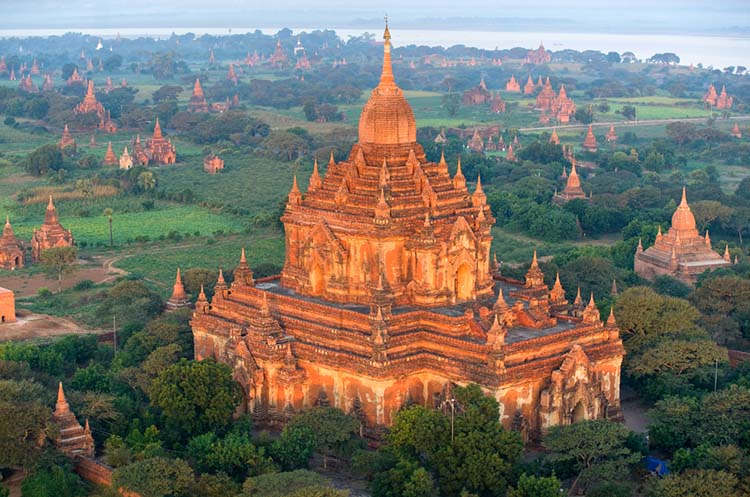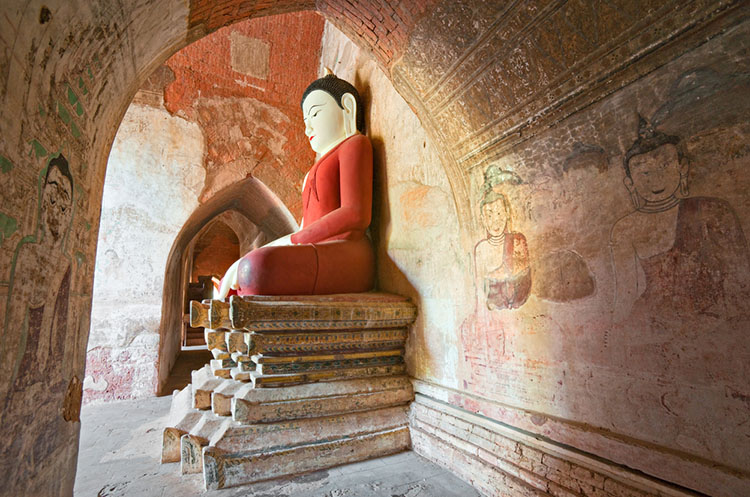
Htilominlo temple
Majestic three storey temple on the plains of Bagan
Three storey
The Htilominlo temple is a large majestic structure towering 46 meters high. Its design is similar to that of the Sulamani, which was build about three decades earlier by the previous King. The monument is named after its builder, King Htilominlo who was also known as Zeya Theinkha and Nadaungmyar.
Selection of Htilominlo as King
According to legend, Htilominlo was chosen to be the next King out of the five sons of King Narapatisithu. The five sons stood in a circle with a white umbrella in the center. When the umbrella would tilt and point towards one of the sons, that son was to be the next King. As the umbrella pointed towards Htilominlo, he was chosen. It is said that the Htilominlo pagoda was built on the spot where he was selected as the next King.
Architecture of the Htilominlo
The Htilominlo is a brick structure, that was originally plastered with white stucco, some of which is still in place. The intricately carved stucco contains depictions of ogresses and mythological animals like Makara sea creatures.
The temple is set on a low platform and has a symmetrical floor plan, but for the Eastern entrance porch that extends further out than the other three. The massive lower cube is topped with three receding terraces. The much smaller second cube has another three terraces. All of them contain small stupas on each of its corners.
Jataka tales
The terraces are fitted with a set of glazed terracotta plaques with scenes from the Jataka tales, the stories about the previous lives of the Buddha. Unfortunately, many of the tiles have not survived.
Each side of the square temple has an entrance porch, that are all richly decorated. The porch of the Eastern gate extends out further from the structure than the other entrances, which breaks the symmetry of the building.
Shikhara and hti topping the Htilominlo
The top of the Htilominlo temple comprises of a shikhara, an ornamental tower originating from Northern India. The shikhara is similar to that of the Ananda, except that it is not gilded. A gilded hti, a spire shaped like an umbrella is placed on the shikhara.

Inside the temple
The walls from the entrances leading to the inner sanctuary contain arched recesses in which small Buddha images are enshrined. Both floors contain four large gilded Buddha images, each facing one side of the temple. The second floor has been closed to visitors.
Murals and frescoes
The temple contains beautiful murals and frescoes of Buddhist depictions done in several colors. Some of them have faded considerably.
To protect the temple from decay, the terraces are closed and it is no longer possible to climb to the top. The complex is surrounded by a wall with elaborate entrance gates. Around the temple are lots of souvenir stalls selling local handicrafts.
The Htilominlo temple was damaged during the 1975 earthquake, and has since been restored.
Getting to the temple
Other temples in Bagan
Among the other temples & pagodas in Bagan are:
- Shwezigon pagoda
- Ananda pagoda
- Gawdawpalin temple
- Sulamani temple
- Thatbyinnyu temple
- Seinnyet sister temples
- Bupaya pagoda
- Mahabodhi temple
- Mingalazedi pagoda
- Dhammayazika pagoda
- Dhammayangyi temple
- Lawkananda pagoda
- Manuha temple
- Pyathadar temple
- Pahtothamya temple
- Myazedi pagoda
- Shwesandaw pagoda
- Gubyaukgyi temple
History
How to get to Bagan and how to get around
- Shwezigon pagoda
- Ananda pagoda
- Gawdawpalin temple
- Sulamani temple
- Thatbyinnyu temple
- Seinnyet sister temples
- Bupaya pagoda
- Mahabodhi temple
- Htilominlo temple
- Mingalazedi pagoda
- Dhammayazika pagoda
- Dhammayangyi temple
- Lawkananda pagoda
- Manuha temple
- Pyathadar temple
- Pahtothamya temple
- Myazedi pagoda
- Shwesandaw pagoda
- Gubyaukgyi temple